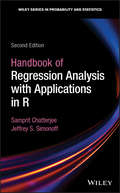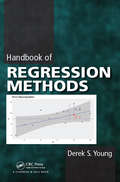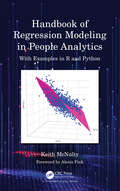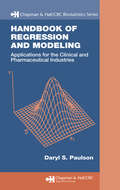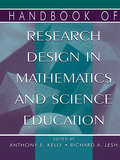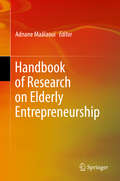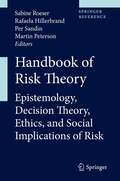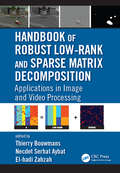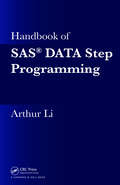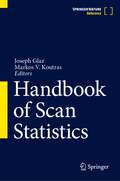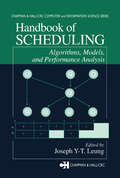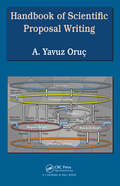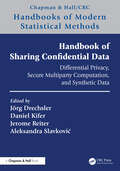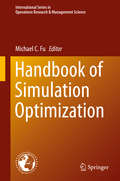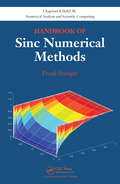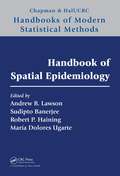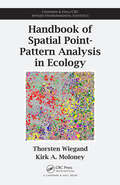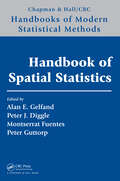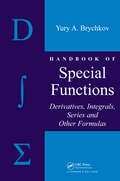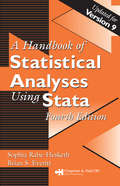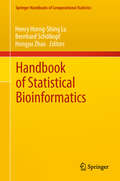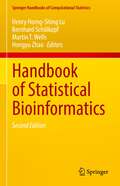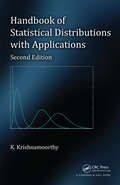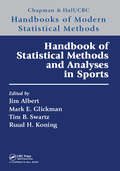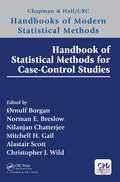- Table View
- List View
Handbook of Regression Analysis With Applications in R (Wiley Series in Probability and Statistics)
by Samprit Chatterjee Jeffrey S. SimonoffHandbook and reference guide for students and practitioners of statistical regression-based analyses in R Handbook of Regression Analysis with Applications in R, Second Edition is a comprehensive and up-to-date guide to conducting complex regressions in the R statistical programming language. The authors’ thorough treatment of “classical” regression analysis in the first edition is complemented here by their discussion of more advanced topics including time-to-event survival data and longitudinal and clustered data. The book further pays particular attention to methods that have become prominent in the last few decades as increasingly large data sets have made new techniques and applications possible. These include: Regularization methods Smoothing methods Tree-based methods In the new edition of the Handbook, the data analyst’s toolkit is explored and expanded. Examples are drawn from a wide variety of real-life applications and data sets. All the utilized R code and data are available via an author-maintained website. Of interest to undergraduate and graduate students taking courses in statistics and regression, the Handbook of Regression Analysis will also be invaluable to practicing data scientists and statisticians.
Handbook of Regression Methods
by Derek Scott YoungHandbook of Regression Methods concisely covers numerous traditional, contemporary, and nonstandard regression methods. The handbook provides a broad overview of regression models, diagnostic procedures, and inference procedures, with emphasis on how these methods are applied. The organization of the handbook benefits both practitioners and researchers, who seek either to obtain a quick understanding of regression methods for specialized problems or to expand their own breadth of knowledge of regression topics. This handbook covers classic material about simple linear regression and multiple linear regression, including assumptions, effective visualizations, and inference procedures. It presents an overview of advanced diagnostic tests, remedial strategies, and model selection procedures. Finally, many chapters are devoted to a diverse range of topics, including censored regression, nonlinear regression, generalized linear models, and semiparametric regression. Features Presents a concise overview of a wide range of regression topics not usually covered in a single text Includes over 80 examples using nearly 70 real datasets, with results obtained using R Offers a Shiny app containing all examples, thus allowing access to the source code and the ability to interact with the analyses
Handbook of Regression Modeling in People Analytics: With Examples in R and Python
by Keith McNultyDespite the recent rapid growth in machine learning and predictive analytics, many of the statistical questions that are faced by researchers and practitioners still involve explaining why something is happening. Regression analysis is the best ‘swiss army knife’ we have for answering these kinds of questions. This book is a learning resource on inferential statistics and regression analysis. It teaches how to do a wide range of statistical analyses in both R and in Python, ranging from simple hypothesis testing to advanced multivariate modelling. Although it is primarily focused on examples related to the analysis of people and talent, the methods easily transfer to any discipline. The book hits a ‘sweet spot’ where there is just enough mathematical theory to support a strong understanding of the methods, but with a step-by-step guide and easily reproducible examples and code, so that the methods can be put into practice immediately. This makes the book accessible to a wide readership, from public and private sector analysts and practitioners to students and researchers. Key Features:• 16 accompanying datasets across a wide range of contexts (e.g. academic, corporate, sports, marketing) • Clear step-by-step instructions on executing the analyses. • Clear guidance on how to interpret results. • Primary instruction in R but added sections for Python coders. • Discussion exercises and data exercises for each of the main chapters.• Final chapter of practice material and datasets ideal for class homework or project work.
Handbook of Regression and Modeling: Applications for the Clinical and Pharmaceutical Industries (Chapman & Hall/CRC Biostatistics Series)
by Daryl S. PaulsonCarefully designed for use by clinical and pharmaceutical researchers and scientists, Handbook of Regression Analysis and Modeling explores statistical methods that have been adapted into biological applications for the quickly evolving field of biostatistics. The author clearly delineates a six-step method for hypothesis testing using data that mi
Handbook of Research Design in Mathematics and Science Education: Innovations In Science, Technology, Engineering, And Mathematics Learning And Teaching
by Richard A. Lesh Anthony E. KellyThe Handbook of Research Design in Mathematics and Science Education is based on results from an NSF-supported project (REC 9450510) aimed at clarifying the nature of principles that govern the effective use of emerging new research designs in mathematics and science education. A primary goal is to describe several of the most important types of research designs that: * have been pioneered recently by mathematics and science educators; * have distinctive characteristics when they are used in projects that focus on mathematics and science education; and * have proven to be especially productive for investigating the kinds of complex, interacting, and adapting systems that underlie the development of mathematics or science students and teachers, or for the development, dissemination, and implementation of innovative programs of mathematics or science instruction. The volume emphasizes research designs that are intended to radically increase the relevance of research to practice, often by involving practitioners in the identification and formulation of the problems to be addressed or in other key roles in the research process. Examples of such research designs include teaching experiments, clinical interviews, analyses of videotapes, action research studies, ethnographic observations, software development studies (or curricula development studies, more generally), and computer modeling studies. This book's second goal is to begin discussions about the nature of appropriate and productive criteria for assessing (and increasing) the quality of research proposals, projects, or publications that are based on the preceding kind of research designs. A final objective is to describe such guidelines in forms that will be useful to graduate students and others who are novices to the fields of mathematics or science education research. The NSF-supported project from which this book developed involved a series of mini conferences in which leading researchers in mathematics and science education developed detailed specifications for the book, and planned and revised chapters to be included. Chapters were also field tested and revised during a series of doctoral research seminars that were sponsored by the University of Wisconsin's OERI-supported National Center for Improving Student Learning and Achievement in Mathematics and Science. In these seminars, computer-based videoconferencing and www-based discussion groups were used to create interactions in which authors of potential chapters served as "guest discussion leaders" responding to questions and comments from doctoral students and faculty members representing more than a dozen leading research universities throughout the USA and abroad. A Web site with additional resource materials related to this book can be found at http://www.soe.purdue.edu/smsc/lesh/ This internet site includes directions for enrolling in seminars, participating in ongoing discussion groups, and submitting or downloading resources which range from videotapes and transcripts, to assessment instruments or theory-based software, to publications or data samples related to the research designs being discussed.
Handbook of Research on Elderly Entrepreneurship
by Adnane MaâlaouiThis handbook introduces readers to the concept of elderly entrepreneurship, and analyzes key issues concerning individuals and institutions. In addition, it presents theoretical and empirical studies exploring the reasons why elderly persons choose to pursue entrepreneurship, despite their advanced age. To investigate this comparatively new entrepreneurial phenomenon, the contributors address psychological, sociological and gerontological aspects, and share unique interdisciplinary insights. The book’s chapters are methodologically diverse, and the scale of analysis ranges from individual cases to country-level patterns. At a time when the world’s major economies are facing a demographic challenge due to ageing populations, elderly entrepreneurship may provide new economic opportunities and motivate more inclusive policymaking.
Handbook of Risk Theory
by Martin Peterson Sabine Roeser Per Sandin Rafaela HillerbrandRisk has become one of the main topics in fields as diverse as engineering, medicine and economics, and it is also studied by social scientists, psychologists and legal scholars. But the topic of risk also leads to more fundamental questions such as: What is risk? What can decision theory contribute to the analysis of risk? What does the human perception of risk mean for society? How should we judge whether a risk is morally acceptable or not? Over the last couple of decades questions like these have attracted interest from philosophers and other scholars into risk theory. This handbook provides for an overview into key topics in a major new field of research. It addresses a wide range of topics, ranging from decision theory, risk perception to ethics and social implications of risk, and it also addresses specific case studies. It aims to promote communication and information among all those who are interested in theoetical issues concerning risk and uncertainty. This handbook brings together internationally leading philosophers and scholars from other disciplines who work on risk theory. The contributions are accessibly written and highly relevant to issues that are studied by risk scholars. We hope that the Handbook of Risk Theory will be a helpful starting point for all risk scholars who are interested in broadening and deepening their current perspectives.
Handbook of Robust Low-Rank and Sparse Matrix Decomposition: Applications in Image and Video Processing
by Thierry Bouwmans, Necdet Serhat Aybat and El-hadi ZahzahHandbook of Robust Low-Rank and Sparse Matrix Decomposition: Applications in Image and Video Processing shows you how robust subspace learning and tracking by decomposition into low-rank and sparse matrices provide a suitable framework for computer vision applications. Incorporating both existing and new ideas, the book conveniently gives you one-stop access to a number of different decompositions, algorithms, implementations, and benchmarking techniques. Divided into five parts, the book begins with an overall introduction to robust principal component analysis (PCA) via decomposition into low-rank and sparse matrices. The second part addresses robust matrix factorization/completion problems while the third part focuses on robust online subspace estimation, learning, and tracking. Covering applications in image and video processing, the fourth part discusses image analysis, image denoising, motion saliency detection, video coding, key frame extraction, and hyperspectral video processing. The final part presents resources and applications in background/foreground separation for video surveillance. With contributions from leading teams around the world, this handbook provides a complete overview of the concepts, theories, algorithms, and applications related to robust low-rank and sparse matrix decompositions. It is designed for researchers, developers, and graduate students in computer vision, image and video processing, real-time architecture, machine learning, and data mining.
Handbook of SAS DATA Step Programming
by Arthur LiThis handbook shows readers how best to manage and manipulate data by using the DATA step in SAS, helping them avoid common problems when creating SAS data sets. The author explains that learning syntax does not solve all problems; rather, a thorough comprehension of SAS processing is needed for successful programming. He also guides readers through a programming task. In most of the examples, the author first presents strategies and steps for solving the problem, then offers a solution, and finally gives a more detailed explanation of the solution.
Handbook of Scan Statistics
by Joseph Glaz Markos V. KoutrasScan statistics, one of the most active research areas in applied probability and statistics, has seen a tremendous growth during the last 25 years. Google Scholar lists about 3,500 hits to references of articles on scan statistics since the year 2020, resulting in over 850 hits to articles per year. This is mainly due to extensive and diverse areas of science and technology where scan statistics have been employed, including: atmospheric and climate sciences, business, computer science, criminology, ecology, epidemiology, finance, genetics and genomics, geographic sciences, medical and health sciences, nutrition, pharmaceutical sciences, physics, quality control and reliability, social networks and veterinary science. This volume of the Handbook of Scan Statistics is a collection of forty chapters, authored by leading experts in the field, outlines the research and the breadthof applications of scan statistics to the numerous areas of science and technology listed above. These chapters present an overview of the theory, methods and computational techniques, related to research in the area of scan statistics and outline future developments. It contains extensive references to research articles, books and relevant computer software. Handbook of Scan Statistics is an excellent reference for researchers and graduate students in applied probability and statistics, as well as for scientists in research areas where scan statistics are used. This volume may also be used as a textbook for a graduate level course on scan statistics.
Handbook of Scheduling: Algorithms, Models, and Performance Analysis (Chapman & Hall/CRC Computer and Information Science Series)
by Joseph Y-T. LeungThis handbook provides full coverage of the most recent and advanced topics in scheduling, assembling researchers from all relevant disciplines to facilitate new insights. Presented in six parts, these experts provides introductory material, complete with tutorials and algorithms, then examine classical scheduling problems. Part 3 explores scheduling models that originate in areas such as computer science, operations research. The following section examines scheduling problems that arise in real-time systems. Part 5 discusses stochastic scheduling and queueing networks, and the final section discusses a range of applications in a variety of areas, from airlines to hospitals.
Handbook of Scientific Proposal Writing
by A.Yavuz OrucInvestigators, their home institutions, and funding agencies play significant roles in the development and outcomes of scientific projects. Submitting a proposal to a funding agency is only one dimension of a multivariable and complex funding process, and understanding this is a good first step toward unlocking the puzzle behind why some research p
Handbook of Sharing Confidential Data: Differential Privacy, Secure Multiparty Computation, and Synthetic Data (ISSN)
by Jörg Drechsler, Daniel Kifer, Jerome Reiter and Aleksandra Slavkovi´cStatistical agencies, research organizations, companies, and other data stewards that seek to share data with the public face a challenging dilemma. They need to protect the privacy and confidentiality of data subjects and their attributes while providing data products that are useful for their intended purposes. In an age when information on data subjects is available from a wide range of data sources, as are the computational resources to obtain that information, this challenge is increasingly difficult. The Handbook of Sharing Confidential Data helps data stewards understand how tools from the data confidentiality literature—specifically, synthetic data, formal privacy, and secure computation—can be used to manage trade-offs in disclosure risk and data usefulness.Key features:• Provides overviews of the potential and the limitations of synthetic data, differential privacy, and secure computation• Offers an accessible review of methods for implementing differential privacy, both from methodological and practical perspectives• Presents perspectives from both computer science and statistical science for addressing data confidentiality and privacy• Describes genuine applications of synthetic data, formal privacy, and secure computation to help practitioners implement these approachesThe handbook is accessible to both researchers and practitioners who work with confidential data. It requires familiarity with basic concepts from probability and data analysis.
Handbook of Simulation Optimization
by Michael C. FuThe Handbook of Simulation Optimization presents an overview of the state of the art of simulation optimization, providing a survey of the most well-established approaches for optimizing stochastic simulation models and a sampling of recent research advances in theory and methodology. Leading contributors cover such topics as discrete optimization via simulation, ranking and selection, efficient simulation budget allocation, random search methods, response surface methodology, stochastic gradient estimation, stochastic approximation, sample average approximation, stochastic constraints, variance reduction techniques, model-based stochastic search methods and Markov decision processes. This single volume should serve as a reference for those already in the field and as a means for those new to the field for understanding and applying the main approaches. The intended audience includes researchers, practitioners and graduate students in the business/engineering fields of operations research, management science, operations management and stochastic control, as well as in economics/finance and computer science.
Handbook of Sinc Numerical Methods (Chapman & Hall/CRC Numerical Analysis and Scientific Computing Series)
by Frank StengerHandbook of Sinc Numerical Methods presents an ideal road map for handling general numeric problems. Reflecting the author’s advances with Sinc since 1995, the text most notably provides a detailed exposition of the Sinc separation of variables method for numerically solving the full range of partial differential equations (PDEs) of interest to scientists and engineers. This new theory, which combines Sinc convolution with the boundary integral equation (IE) approach, makes for exponentially faster convergence to solutions of differential equations. The basis for the approach is the Sinc method of approximating almost every type of operation stemming from calculus via easily computed matrices of very low dimension.The downloadable resources of this handbook contain roughly 450 MATLAB® programs corresponding to exponentially convergent numerical algorithms for solving nearly every computational problem of science and engineering. While the book makes Sinc methods accessible to users wanting to bypass the complete theory, it also offers sufficient theoretical details for readers who do want a full working understanding of this exciting area of numerical analysis.
Handbook of Spatial Epidemiology (Chapman & Hall/CRC Handbooks of Modern Statistical Methods)
by Andrew B. Lawson María Dolores Ugarte Sudipto Banerjee Robert P. HainingHandbook of Spatial Epidemiology explains how to model epidemiological problems and improve inference about disease etiology from a geographical perspective. Top epidemiologists, geographers, and statisticians share interdisciplinary viewpoints on analyzing spatial data and space-time variations in disease incidences. These analyses can provide imp
Handbook of Spatial Point-Pattern Analysis in Ecology (Chapman & Hall/CRC Applied Environmental Statistics)
by Thorsten Wiegand Kirk A. MoloneyThis handbook shows how the techniques of point-pattern analysis are useful for tackling ecological problems. Within an ecological framework, it guides readers through a variety of methods for different data types and aids in the interpretation of the results obtained by point-pattern analysis. Along with the techniques, the book provides a comprehensive selection of real-world examples. Most of the examples are analyzed using the authors' software package Programita. The software and a manual are available online.
Handbook of Spatial Statistics (Chapman & Hall/CRC Handbooks of Modern Statistical Methods)
by Peter J. Diggle Peter Guttorp Alan E. Gelfand Montserrat FuentesAssembling a collection of very prominent researchers in the field, the Handbook of Spatial Statistics presents a comprehensive treatment of both classical and state-of-the-art aspects of this maturing area. It takes a unified, integrated approach to the material, providing cross-references among chapters.The handbook begins with a historical intro
Handbook of Special Functions: Derivatives, Integrals, Series and Other Formulas
by Yury A. BrychkovBecause of the numerous applications involved in this field, the theory of special functions is under permanent development, especially regarding the requirements for modern computer algebra methods. The Handbook of Special Functions provides in-depth coverage of special functions, which are used to help solve many of the most difficult problems in
Handbook of Statistical Analyses Using Stata
by Brian S. Everitt Sophia Rabe-HeskethWith each new release of Stata, a comprehensive resource is needed to highlight the improvements as well as discuss the fundamentals of the software. Fulfilling this need, AHandbook of Statistical Analyses Using Stata, Fourth Edition has been fully updated to provide an introduction to Stata version 9. This edition covers many
Handbook of Statistical Bioinformatics
by Bernhard Schölkopf Henry Horng-Shing Lu Hongyu ZhaoNumerous fascinating breakthroughs in biotechnology have generated large volumes and diverse types of high throughput data that demand the development of efficient and appropriate tools in computational statistics integrated with biological knowledge and computational algorithms. This volume collects contributed chapters from leading researchers to survey the many active research topics and promote the visibility of this research area. This volume is intended to provide an introductory and reference book for students and researchers who are interested in the recent developments of computational statistics in computational biology.
Handbook of Statistical Bioinformatics (Springer Handbooks of Computational Statistics)
by Bernhard Schölkopf Henry Horng-Shing Lu Hongyu Zhao Martin T. WellsNow in its second edition, this handbook collects authoritative contributions on modern methods and tools in statistical bioinformatics with a focus on the interface between computational statistics and cutting-edge developments in computational biology. The three parts of the book cover statistical methods for single-cell analysis, network analysis, and systems biology, with contributions by leading experts addressing key topics in probabilistic and statistical modeling and the analysis of massive data sets generated by modern biotechnology. This handbook will serve as a useful reference source for students, researchers and practitioners in statistics, computer science and biological and biomedical research, who are interested in the latest developments in computational statistics as applied to computational biology.
Handbook of Statistical Distributions with Applications (Statistics: A Series of Textbooks and Monographs)
by K. KrishnamoorthyEasy-to-Use Reference and Software for Statistical Modeling and TestingHandbook of Statistical Distributions with Applications, Second Edition provides quick access to common and specialized probability distributions for modeling practical problems and performing statistical calculations. Along with many new examples and results, this edition inclu
Handbook of Statistical Methods and Analyses in Sports (Chapman & Hall/CRC Handbooks of Modern Statistical Methods)
by Jim Albert Mark E. Glickman Ruud H. Koning Tim B. SwartzThis handbook will provide both overviews of statistical methods in sports and in-depth treatment of critical problems and challenges confronting statistical research in sports. The material in the handbook will be organized by major sport (baseball, football, hockey, basketball, and soccer) followed by a section on other sports and general statistical design and analysis issues that are common to all sports. This handbook has the potential to become the standard reference for obtaining the necessary background to conduct serious statistical analyses for sports applications and to appreciate scholarly work in this expanding area.
Handbook of Statistical Methods for Case-Control Studies (Chapman & Hall/CRC Handbooks of Modern Statistical Methods)
by Nilanjan Chatterjee Mitchell H. Gail Ørnulf Borgan Norman Breslow Alastair Scott Chris J. WildHandbook of Statistical Methods for Case-Control Studies is written by leading researchers in the field. It provides an in-depth treatment of up-to-date and currently developing statistical methods for the design and analysis of case-control studies, as well as a review of classical principles and methods. The handbook is designed to serve as a reference text for biostatisticians and quantitatively-oriented epidemiologists who are working on the design and analysis of case-control studies or on related statistical methods research. Though not specifically intended as a textbook, it may also be used as a backup reference text for graduate level courses. Book Sections Classical designs and causal inference, measurement error, power, and small-sample inference Designs that use full-cohort information Time-to-event data Genetic epidemiology About the Editors Ørnulf Borgan is Professor of Statistics, University of Oslo. His book with Andersen, Gill and Keiding on counting processes in survival analysis is a world classic. Norman E. Breslow was, at the time of his death, Professor Emeritus in Biostatistics, University of Washington. For decades, his book with Nick Day has been the authoritative text on case-control methodology. Nilanjan Chatterjee is Bloomberg Distinguished Professor, Johns Hopkins University. He leads a broad research program in statistical methods for modern large scale biomedical studies. Mitchell H. Gail is a Senior Investigator at the National Cancer Institute. His research includes modeling absolute risk of disease, intervention trials, and statistical methods for epidemiology. Alastair Scott was, at the time of his death, Professor Emeritus of Statistics, University of Auckland. He was a major contributor to using survey sampling methods for analyzing case-control data. Chris J. Wild is Professor of Statistics, University of Auckland. His research includes nonlinear regression and methods for fitting models to response-selective data.
